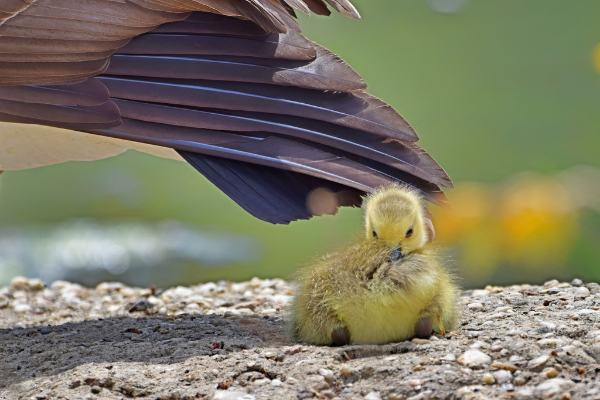Seeing newborn wildlife in the springtime never gets old for me, especially Canada goose goslings. The sight of their fluffy, yellowish down bodies waddling around, pecking grasses with their parents, fills me with joy.
Plus their immediate joie de vivre is impressive and admirable.
Goslings hatch with their eyes open and leave the nest within 24 hours, following their parents. They can walk, swim, feed and even dive at just one to two days old, depending on the conditions.
In less than two months, the goslings develop adult feathers and learn to fly. By the time they are two months old they are 25 times bigger than they were at birth. Research indicates they are even aware of various hazards lurking in the environment around them throughout their first summer. They’re known to be afraid of fox footprints on the ground or a bird of prey swooping overhead. Young goslings may be preyed upon by snapping turtles, gulls, owls, and coyotes.
Little do they know though, that as adults, their biggest threat will be impatient, intolerant humans who have an issue with cleaning up after them— especially during molting, their flightless period.
Long flights put a lot of strain on their feathers. Each summer, as they are raising and enjoying their families, Canada geese molt out the old, worn feathers and grow new ones from late June through mid-August. They will select open areas near water and a food source so they can walk or swim everywhere that they need while grounded. Ponds, lakes and bays serve as excellent locations, as well mowed lawns, parks, and golf courses.
So while the beginning of summer coupled with Fourth of July celebrations signify people’s favorite time of the year—for Canada geese it’s anything but. This time of year brings out the worst in people. Harassment measures and even worse, geese roundups and slaughter take place because intolerant people think their community will be overcome with feces. It’s absurd.
This is precisely the time of year special attention to cleanup is most essential. And the truth is, these days it’s easier than ever to institute clean-up programs that rid an area of goose droppings. For instance, in the U.S., Georgia-based manufacturer Tow and Farm offers different size pieces of equipment—its Tow and Collect series—that provide an efficient method of collecting goose feces.
Cities like Ottawa, Canada and Boston have had much success. Kudos to them for figuring out that Canada geese want to enjoy their families over the summer just like people do. And they should be left alone to do just that!

